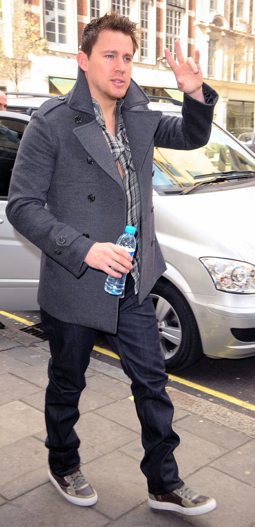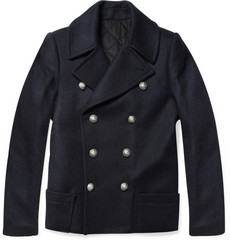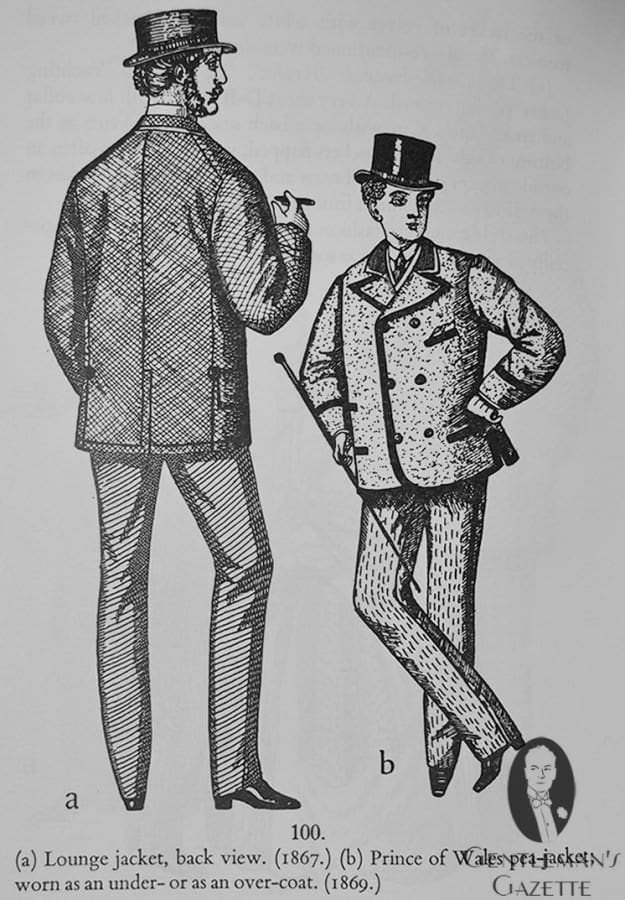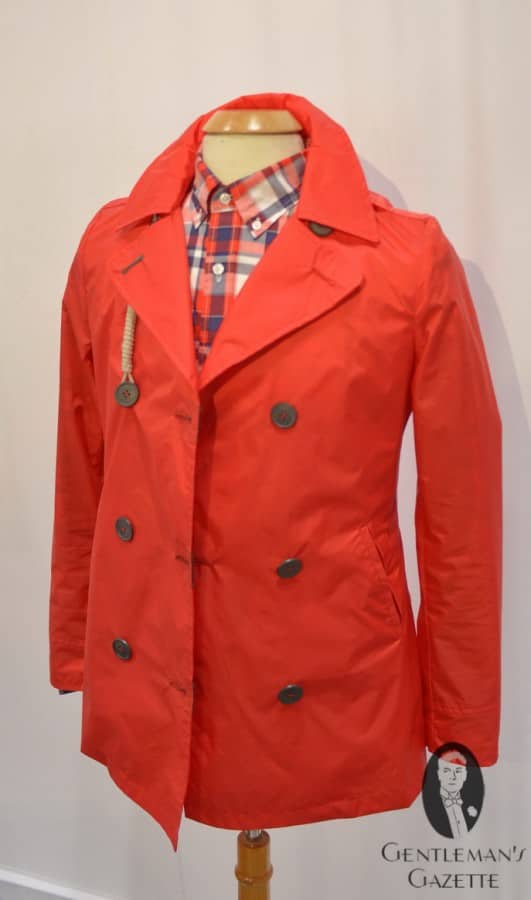Jag gillar hösten..
Eller sensommaren kanske man ska kalla det..
För att på dagarna vill jag klä mej lagom lätt.. Och på kvällarna vill jag kunna bära en snygg jacka.
Jag är en kille med många jackor.. Och har man en massa olika jackor..
Så är det nästan ett måste med att ha alla dessa klassikers.
Jag har redan tagit upp dom flesta..
(Klicka på dom som fungerar som länkar för att läsa mina tidigare inlägg)
* College Jackan
* Baracuta Jackan
* Skepparrock/kavaj
* Burberry Trenchcoat
* Både lång och kort överrock
* Skinnjacka i MC-stil
* Skinnjacka i pilot-stil
* Barbour Oljerock
* Bomberjackan
Men en som jag inte har tagit upp detaljerat ännu är Skepparjackan.
För några höstar sedan så var jag helt bestämd att jag skulle ha en klassisk skepparjacka utan en massa krussiduller.
Och det visade sej vara MYCKET svårare än jag trodde..
Det var nog t.o.m som så att det var först hösten/vinter därpå som jag slutligen fick tag på en.
Jag letade överallt.. ÖVERALLT..
Frågade i alla butiker.. Allt.
Och jag kunde inte alls alls förstå.. Att en sån klassiker.. Ett sånt säkert kort.. Inte gick att få tag på.
Men slutligen, efter många om och men.. Så kunde jag beställa en PERFEKT ifrån Burberry.
Så nu.. Denna sommaren.. Så har jag nästan längtat lite efter att få kunna bära den igen.
Problemet är bara nu… Att efter nyss ha köpt två nya jackor i storlek XL..
Så inser jag.. Att XL/54 passar inte mej längre..
Så det är knappt att jag vågar pröva min skepparjacka nu..
Men nog om mej och min fysiska storlek…
Nu är det dags för ännu en historielektion..
Det var ett tag sedan.
Första gången ordet ”Peacoat”, Som den kallas på Engelska, Första gången det ordet nämndes i Oxford English Dictionary var redan 1717… Så vi snackar alltså en RIKTIG klassiker här.
Och denna dubbelknäppta yllerock har aldrig gått ur tiden..
Well förutom just då när jag bestämde mej för att skaffa en 😉
Jag kanske ska börja med det engelska ordet för jackan.. Peajacket..
Alltså det har inget med ärtor att göra.. Det är jag säker på..
Men sen så är där lite olika bud på hur jackan fick det namnet.
Det kan vara ifrån det Holländska ”Pijjakker”, Som var en yllejacka som byggnadsarbetarna bar på 1700-talet.
Eller om det kommer ifrån ordet ”P-jacket”, Som är den militära termen för en jacka som bars är kaptener eller navigatorer.
Men.. Ett kärt barn har många namn.. Världen över..
Så jag har sett att den kallas för ”Reefer jacket” och ”officers coat” också.
Men en ”arbetar-jacka” för dom som jobbar till sjö´s har det alltid varit.


Den moderna versionen av jackan, Som är dubbelknäppt, kort(are), rund hals
och med axelflappar
(Som jag inte alls gillar och det var det svåraste när jag letade jacka att hitta en utan nått på axlarna) har sitt ursprung ifrån US Navy på 1940 talet.. Kanske tidigare.

Dessa var grundade på den längre modellen som brittiska seglare hade använt sen 1850.
Med knapparna lite bredare ut, Med den höga kragen för att skydda nacken mot vind.. Dvs den modellen jag har och jag gillar bäst.
Sen så funkar det med kragen både upp eller nere..
Men en styv krage som GÅR att bära uppe måste det vara tycker jag.





Till skillnad från en vanlig blazer eller rock som är dubbelknäppt, så tycker jag att en skepparjacka är snyggast knäpp.. Eller minst lika snygg som oknäppt iallafall.

Alltså.. Jag är sån att jag tycker inte om att känna mej instängd.. Därför stänger jag väldigt sällan mina jackor..
Men en skepparjacka tycker jag ska sitta åt lite.. Ska vara stängd..
Du ska alltid se ut som om det är kallt och blåsigt ute när du bär en skepparjacka 😉
Och framför allt så ska den sitta rätt..
För.. Det är lite uniformkänsla ändå i en skepparjacka..
Även om det är ett plagg som funkar vid alla tillfällen..
Om du så är lite uppklädd, Har kavaj under.. Eller om du bara har en stickad tröja och jeans.. Eller kanske t.o.m bara en T-Shirt under.

i Paris är det vanligaste att man bär en skjorta,
Med några knappar uppknäppta, En rundhalsad kofta över,
Slimmade. mörka, Klassiska Jeans, Halsduk, Och boots till sin skepparjacka.
Själv så föredrar jag kaptenlooken.. Kofta må vara.. Kanske med sidoöppning.. En polo kanske..

Skäggig..

tjock stickad mössa..
Boots givetvis även om det funkar med låga skor också..
Eller bara en helt vit T-Shirt och sneakers.


Viktigast av allt är som vanligt, Att allt sitter som det ska.
Därför är jag rädd att min är lite för liten för mej nu.
Skepparjackan faller nånstans mellan smart klädd.. Lite det jag menar med arbetarkläder..
Den gör sitt jobb liksom..
Och mellan att vara en mer relaxed, casual jacka..
Det är därför du egentligen inte ska bära den över en kostym.. Eftersom den har sitt ursprung från att vara en arbetarjacka..

Det är på senare tid.. Med hjälp av filmens värld.. Som en skepparjacka har blivit något snyggt och classy.
Men ingen skulle se dej som nedklädd om du har en skepparjacka istället för en kavaj eller blazer en kall dag.

Så.. Det är väl dom många användningsområdena som gör jackan till en självklar klassiker.. Utöver dess gamla historik.
Är du ute efter en skepparjacka idag, Så har du inga problem alls att hitta nått just i din smak eller prisklass.
För nu är det ”inne igen”..
Även om det aldrig varit ute..
Så vill du ha en jacka som värmer dej om hösten.. och som du kan använda till allt..
Så kör på en skepparjacka.


Jag gillade knapparna.. Men inte alls att den var så kort, eller sidofuckorna.
Peacoat History
Unlike the more defined history of the Trench Coat, the origins of the peacoat are more ambiguous. However, there are several differing versions of the peacoat story out there, so I will share them here to see which one makes the most sense to you. Like many garments, the history of the peacoat may not be exact, but it has certainly left an indelible impression upon classic fashion.
The Dutch Version
The Oxford Dictionary dates the origin of the pea jacket or peacoat to the early 18th century, claiming that it was probably derived from the Dutch word pijjakker, from “pij” for ‘coat of coarse cloth’ + jekker for ‘jacket’. The change from “jekker” to “jakker” was due to association with a jacket, as described by the dictionary. Since the Dutch were a naval power back in the day, and the peacoat is commonly associated with seafaring, it does not seem far-fetched that the jacket was in fact from the Netherlands.
The UK Version
According to Camplin, one Mr. Edgard Camplin founded a store in 1850 in which he sold uniforms to the British navy. Apparently, he sold particularly well in India, starting in 1888. After that, Mr. Camplin supposedly suggested – at an unknown date – to create a coat for the uniform of petty officers, who had the same uniform as sailors up until then. Instead of the officer’s great coat, the Camplin designed the Petty Coat, which was also known as a P. Coat, which was then popularized as Peacoat for phonetic reasons. Personally, I find this theory questionable because it does not name any sources or dates.
The Reefer Version
It seems safe to say that the US Navy adopted the Peacoat from the Royal British Navy. Some claim the peacoat as we know it today was originally designed for “reefers”, which were the sailors who had to climb the riggings of sailing ships.
Hence, we also have to term reefer coat, which describes a double breasted navy coat that is close fitting and short to allow the wearer to climb the ropes.
This theory seems to make sense, but, unfortunately, it lacks historic evidence.
Tailor & Cutter Version
The Tailor & Cutter used to be the leading tailor trade magazine in England in the 19th century. It was published weekly and in addition to focusing on tailoring and cutting, it also featured fashion trends and etiquette. For example, if people began wearing new styles, Tailor & Cutter would comment on the clothing, which was particularly true for anything a Royal wore. In an issue from October 1868, they report about the so-called “the Prince of Wales Jacket” emerged, which characterized it as a loose double breasted jacket with three pairs of buttons, two cross pockets, and wide piping. When intended for rough use, the coat was made of blue pilot-cloth lined with wool. For town wear, it was made of blue witneyor another soft material with silk-faced lapels and a velvet collar. It was tailored with or without a back-seam and with short vents at the bottom. The illustration is from 1869 and describes it as a “Prince of Wales pea-jacket”. Chances are, the PoW was not the inventor, but rather he popularized it – in any case this magazine from that time proves that the pea jacket existed in 1869.
The Cut of a Peacoat
The peacoat of the late 19th century was close fitting with a bit of a flair line on the hips so that the reefers could climb the ropes. It is cut slightly longer than a regular jacket, but it remains shorter than a greatcoat to accommodate the specific job tasks of its wearers.
The over-sized Ulster collar can be buttoned up to the seventh button to protect the wearer from the elements. If sailors wore many layers underneath, they were sometimes unable to button that 7th button and so they used cordage.
The very first peacoats seem to have had short side vents or no vents, whereas current US Navy peacoats feature a center vent. The vertical slit pockets were designed for easy access, and they usually also feature a little change pocket on the inside because US Navy pants did not have pockets. On the inside, you will find two pockets on either side for storage of your wallet, etc.
Without any belts in the back or buttons on the sleeve cuffs, a peacoat is a rather simple and mostly functional garment.
Today, the US Navy provides the following features for a peacoat:
- Males: A double-breasted, hip length coat made of dark blue authorized fabric with a convertible collar, a set-in pocket in each forefront, and a single row of four 35-line black plastic anchor buttons down the right front and three on left. Men’s peacoat buttons to the right.
- Females: A double-breasted, hip length coat made of dark blue authorized fabric with a convertible collar, shoulder epaulets, a set-in pocket in each forefront, and a single row of four 35-line black plastic anchor buttons down the left front and three on right. Women’s peacoat buttons to the left. Women may wear either the men’s peacoat (without epaulets) or the women’s peacoat (with epaulets) as long as serviceable.
- Correct Wear: Button all buttons except collar button. Collar button may be buttoned in inclement weather. Wear the jumper collar inside the coat. Sleeves are to reach about three-quarters of the distance from the wrist to the knuckles when arms hang naturally at the sides.
- Ownership Markings: Center last name and last four digits of SSN three inches from and parallel to the bottom edge of the peacoat.
Peacoat Fabric
Today, the US Navy peacoat is made of a midnight blue 24 oz / 750 grams Melton of 80% wool and 20% artificial fibers. Traditionally, it was made of 100% Kersey wool, just like the Melton for the British Warm. As pointed out above, the pilot fabric was a choice and later 100% wool Melton or Kersey was used, often in weights up to 34 oz. / 1050 / grams per yard / meter. Today, you can still find 100% wool melton fabrics, but usually not heavier than 24 oz, which is a shame because the heavier fabrics wore quite warm in my opinion. If you can, get a heavy weight vintage coat, though good examples in decent shape are few and far between. If you opt for a modern version, skip the nylon and polyester blends and invest a bit more.
Occasionally, you will also find peacoats made in different materials such as canvas, cotton or nylon, but technically, these are not peacoats anymore.
Buttons of a Peacoat
Throughout history, peacoats had a varying number of front buttons. During WWI they often had 10 buttons, later 8 and now mostly 6 with one hidden button under the right collar.
Today, US Navy peacoats feature large (35-ligne) thick black plastic buttons. Imprinted on the front is a “fouled anchor” design, which refers to the traditional image of an anchor wrapped in a rope. Apparently, the tradition of this logo dates back to the personal seal of Lord Howard of Effingham, the Lord High Admiral of England, when the British defeated the Spanish Armada in 1588. Following the victory, the design was then adopted as the official seal of the Lord High Admiral of Great Britain.
Every once in a while, you will also see gold brass buttons on a midnight blue peacoat. Traditionally, officers, warrant officers or chief petty officers could upgrade their peacoats with these buttons.
Starting in the early 20th century, peacoat buttons featured the large fouled anchor in the center with a ring of 13 stars surrounding it, spaced along the edge of the button face. At that time, the coat was also longer and had two additional horizontal pockets.
By the 1920s, peacoats had the buttons that are used today, but in the 1970’s Admiral Elmo Zumwalt had these buttons replaced with 40-ligne (1″) metal buttons that looked identical to the gold ones worn by officers, with the exception that they had a pewter color.
The pewter “Zumwalt” buttons do have an anchor in the design, but only as a perch for a large eagle; they also feature a small stack of cannonballs. In 1984, the pewter buttons disappeared again, and “traditional” fouled anchor buttons returned.
While variants of the peacoat are used by many navies, and most use buttons with some variant of the fouled anchor design (with a crown, if the country is a kingdom), it is also true that many of these buttons are of brass, gold plated or not; or of anodized aluminum (“Stabrite”). Sometimes the buttons are of black plastic or horn, but with metal shanks rather than four holes for sewing.
Some will argue that an authentic US Navy peacoat must have the black anchor plastic buttons, but you should bear in mind that as a civilian, you can wear whatever you want. For example, I think it looks great with gold buttons, pewter buttons, horn buttons or mother of pearl buttons.
Personally, I have an original US Navy 100% wool officer’s peacoat with gold buttons from the 1980’s.
Where & How to Buy a Peacoat
If you want to buy a US Navy Peacoat, you can either buy a new one or a vintage one. As I mentioned before, the current offerings often have nylon blended into the fabric and are thinner while older versions in good shape are not easy to find. But no matter what you buy, the sizing has to be right to look good.
Sizing
Traditionally peacoats are worn fitted, but not so tight that the vent gaps or you have wrinkles when buttoning the coat. Of course, you can wear a coat, however, wide you want. To find the right size for you, you have to determine how you like the fit of your peacoat and physically measure your chest with a measuring tape.

Vintage WWII Peacoat Tag
For example, my chest is 44 inches, and I wear a 42L peacoat, which measures 45 inches in the chest. I am 6 ft tall with long arms, which is why I opted for the long version rather than the regular model. I do have enough space to wear a thick sweater or even a jacket underneath of it. In case you want to wear less, you should size down by more than two inches. If you like it roomier size up – it’s that simple.
Vintage Peacoats
Older peacoats were generally cut a little trimmer: WWII coats were the most fitted ones.
The models from the 1950’s and 1960’s were already a littler bigger, and the 1970’s version is once again bigger but a bit slimmer than the 1980’s versions. The current model is cut the widest. With a WWII coat, a 44L would probably be as wide as 1980’s 42 L.
Sometimes, older coats do not have size measurements and in general, I would always go with measurements instead of sizes. Back length, sleeve length, shoulder width and chest width and maybe the waist should be enough to determine whether it will fit or not. Of course, if you have sloping shoulders or a round back it may not fit you, but an alterations tailor should be able to help you if these primary measurements are correct.
Sources for Vintage Coats
Ebay probably offers the largest selection of vintage peacoats, but if you live in the US, consignment stores may also offer one every once in a while. I put together a collection of 60+ peacoats here so take a look.
New
There are some other clothing companies that offer peacoats, but most have added their own design influences. For a peacoat with an authentic cut in 100% wool, I would buy the Navigator from Sterlingwear of Boston, which produces peacoats for members of the US Navy. Since they produce so many of them, they can offer this 24oz wool melton version for just $265.
If you are not concerned about authenticity, the peacoat from Camplin (now Italian-owned) may be the right choice for you. They come in various colors, but they also cost two and a half times as much as the US-made ones.
Army-Navy surplus stores are likely to have the modern wool-synthetic blends; online surplus stores (examples here and here) also carry a variety of peacoats. While these are very affordable, and they come in thick 32 oz melton fabric, they are made out of reprocessed wool and nylon fibers, with polyester padding and quilted nylon lining, which is simply unacceptable to me.
Of course, all the fashion brands like Burberry, Aquascutum carry what they call Pea Coats but they are not the real deal. Even houses like Gieves & Hawkes only offer Made in Italy interpretations of the original with flap pockets and cashmere blends… If you like the look of these coats, wear them but these are not peacoats.
How to Date Your Vintage Peacoat
If you came into possession of a vintage peacoat and you wonder how old it is, or you just want to know when certain details like mid brown corduroy lined pockets were available.
Peacoats From WWI
Peacoats have been around for longer, but it is difficult to find older pictures. As you can see the Peacoat had 10 or more buttons, and they were longer. It featured handwarmer pockets as well as flapped pockets. The original buttons featured an anchor with 13 stars around them, and the color was midnight blue. So it should be very easy to date a WWI peacoat if you find one.
Peacoats From WWII
Compared to the WWI peacoats, the hand warmer pockets were placed a bit lower, and the flap pockets disappeared, but it still maintained the 10 button front. The buttons changed considerably and now featured the fouled anchor you may be familiar with today. At the same time, the stars were removed.
The outer shell was still 100% midnight blue Kersey wool, and the pockets were lined with tan or light brown corduroyand inside the chest pocket you could find a label stating “Manufactured By NAVAL CLOTHING FACTORY.”
The fit of WWII peacoats was very tight compared to the ones that followed.
Peacoats Post WWII
Traditionally, the peacoat had 10 buttons, 8 of which were visible. Sometime after the war the number was reduced to 8 with just 6 visible ones and eventually, just 7 with 6 visible ones.
Because of the reduction in buttons, the lapel got slightly bigger, and you could now see more of the chest or tie. Of course, you could still button it up all the way to keep you warm when needed. Up until the 1970s the 100%, Kersey wool remained unchanged. At some point after that, poly blended wool was offered. The style of the coat was maintained between 1946–1979, though the tags were often different, thus making it difficult to date.
However, little details changed. For example in 1968, the corduroy pocket lining was substituted with a soft blue, white, off-white cotton lining.
From 1974 to 1984 the buttons were exchanged once again, so the shape would match the gold bridge coats but the color was pewter. In 1984, the black fouled anchor button was reintroduced but the bridge coats kept their gold buttons.
During that same period, Melton was introduced along with some other changes.
Peacoats Today
Peacoats today are manufactured by Sterlingwear of Boston, who also offer a civilian version in black. They make a decent quality military peacoat from the Melton wool, but you might want to go with an original instead. For even more details about dating a vintage peacoat, you should take a look here.
Conclusion
In the end, the peacoat is a classic, functional closet staple that has been around for more than a century. The original midnight blue version with black anchor buttons is certainly the most popular, but nowadays you do have a choice of different materials and colors. No matter whether you go vintage or new, a peacoat is ideal when you want to keep warm but a long overcoat would be too formal and a puffy down jacket à la Moncler is simply not your style.
What peacoats do you own? Please share your pictures with us and let us know what your favorite looks like, thanks!



























